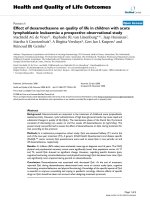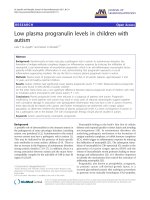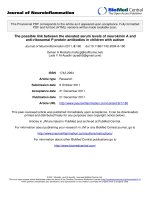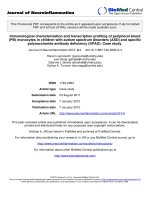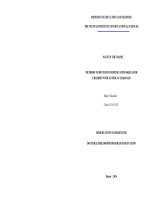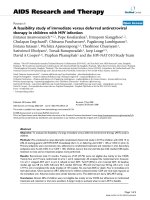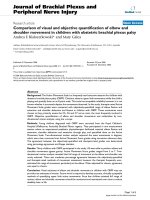Enhanced cognitive processing by viewing snakes in children with autism spectrum disorder. A preliminary study
Bạn đang xem bản rút gọn của tài liệu. Xem và tải ngay bản đầy đủ của tài liệu tại đây (1.57 MB, 7 trang )
Grandgeorge et al. BMC Psychology
(2019) 7:74
/>
RESEARCH ARTICLE
Open Access
Enhanced cognitive processing by viewing
snakes in children with autism spectrum
disorder. A preliminary study
Marine Grandgeorge1,2* , Alban Lemasson2, Martine Hausberger3, Hiroki Koda4 and Nobuo Masataka4
Abstract
Background: Prioritization of the processing of threatening stimuli induces deleterious effects on task performance.
However, emotion evoked by viewing images of snakes exerts a facilitating effect upon making judgments of their
color in neurotypical adults and schoolchildren. We attempted to confirm this in school and preschool children
with and without Autism Spectrum Disorder (ASD).
Methods: Forty French children participated and corresponded to two age groups: a group of schoolchildren and
a group of preschool children, each group including 10 children with typical development and 10 children with
ASD. Each participant was exposed to 120 trials composed of 20 photographs of snakes and 20 photographs of
flowers, each of which appeared 3 times (in red, green and blue). Participants were asked to indicate the color of
each image as quickly as possible via key-press. A three-way analysis of variance test for reaction time (RT) considering
image type (IMAGE), participant group (PARTICIPANT), and age (AGE) as main effects and its interaction terms was
performed for each subject.
Results: When the reaction time required to respond to presented stimuli was measured, schoolchildren tended to
respond faster when stimuli were snake images than when stimuli were flower images whether the children had or
did not have ASD. For the 5-to-6-year-old preschool participants, the difference between reaction time for the colornaming of snake images and flower images was ambiguous overall.
Conclusions: There were possible odd color-specific effects in children with ASD when images were presented to the
children in green. Implications of the findings are argued with respect to active avoidance or attraction as one of the
behavioral characteristics commonly noted in children with ASD.
Keywords: Snake fear, Emotion, Stroop effect, Autism spectrum disorder, Anxiety
Background
To what extent does our performance depend on how we
feel? Attempts to answer this question have involved research both on emotion and on cognition. So far, unfortunately, it has generally been assumed conventionally, but
with little experimental evidence, that deleterious effects
on task performance are a consequence of prioritization of
the processing of threatening stimuli [1–3]. More recently,
* Correspondence:
1
Centre de Ressources Autisme, CHRU of Brest, Hospital of Bohars, Bohars,
France
2
Marine Grandgeorge, Université de Rennes 1, Ethologie Animale et
Humaine, EthoS, UMR 6552, CNRS, Université Caen Normandie, Paimpont,
France
Full list of author information is available at the end of the article
however, some evidence has been presented that challenges this notion. For example, a prior exposure to a fearful face picture enhanced subsequent visual processing
[4]. Moreover, in a recent study [5], adults and schoolchildren needed to name the color of images of snakes and
flowers using the pictorial emotional Stroop paradigm [6].
Reaction time (RT) to answer was significantly shorter for
snake images than for flower images. This was quite surprising, as snake stimuli had a robust attentional bias, in
opposition to the reasoning believed in traditional psychobiological studies [7, 8]. In studies such as the one cited
above showing a short reaction time to answer the color
of snakes, negative emotions such as fear may have an
© The Author(s). 2019 Open Access This article is distributed under the terms of the Creative Commons Attribution 4.0
International License ( which permits unrestricted use, distribution, and
reproduction in any medium, provided you give appropriate credit to the original author(s) and the source, provide a link to
the Creative Commons license, and indicate if changes were made. The Creative Commons Public Domain Dedication waiver
( applies to the data made available in this article, unless otherwise stated.
Grandgeorge et al. BMC Psychology
(2019) 7:74
enhancing effect on cognitive processing of stimuli so long
as the stimuli are evolutionally relevant threatening ones.
All previous research about such an enhancing effect
concerned individuals with typical development. To date,
no such attempts have been reported in atypical populations, such as people with autism spectrum disorder
(ASD), who need to cope with particular atypical functioning of emotion and cognition e.g. [9]. Although ASD
is not classified as an anxiety disorder, it is associated
with comorbid anxiety [10, 11]. Indeed, people with
ASD were reported to display more anxiety than people
with typical development (34–64% versus 5–20% [12],
and around 40% displayed atypical and intense fears
[13]. For example, children with ASD are more afraid of
animals than children with typical development [14].
These fears may interfere significantly with functioning,
and thus have a great impact on the daily life as well as on
the family network of people with ASD [15], and consequently they often lead to social withdrawal and avoidance
[16]. As Mayes et al. [12] explained, “children with ASD
may avoid necessary life situations (e.g., refusing to go to
school because there may be a fire drill) or be in a constant state of anxiety and unable to function optimally because of their fears”. These situations may lead to strong
negative emotional states, e.g., anxiety crises. Moreover,
sensorial alterations are present in the core of ASD, for
example, these people can be attracted or repulsed by visual stimuli [17] that do not cause such effects in typical
development, e.g., preferred or avoided color(s) [18] or
color obsession [19, 20]. Likewise, many descriptions of
people with ASD showed atypical processing of emotional
stimuli [21], though impairments may be more evident
when tests involve recognition of complex rather than
basic emotions [22]. Similarly, in complex tasks, several
studies have found that threatening targets presented during the attentional blink are spared (accurately detected)
relative to neutral targets, but it appears that ASD and
high levels of autistic traits are linked to an absence of the
sparing described above, suggesting that the emotional information is processed differently by people with ASD
[23–25]. Indeed, the results of a recent study revealed that
attentional bias toward snakes that was observed in a visual search task was enhanced in children with ASD compared to typically developing (TD) children [26],
suggesting that the fear response is more extreme in children with ASD. However, to date, the literature gives little
information about the cognitive processing involved, even
if such data exist for children with typical development. In
the case of an emergency, it would be adaptive if the cognitive processing would work effectively in NT children.
And if such an emergency were experienced with more
anxiety in children with ASD, one could argue that their
more extreme fear response would adaptively enhance
cognitive processing in them.
Page 2 of 7
The present study was undertaken based on the paradigm employed by these previous studies, and was extended to children with ASD as participants. We
hypothesized that negative emotion may have a stronger
effect on cognitive processing in ASD children. In our
current study, we used snake images and flower images
as biologically relevant threatening stimuli and biologically attracting stimuli. If the cognitive processing of the
colors of snake images as evolutionally relevant threatening stimuli is enhanced by emotion (perhaps fear)
induced by looking at images, such facilitating effects
should be similarly robust, and probably higher, in children with ASD than in children without ASD. To test
this hypothesis, we included children with and without
ASD, from two different age sub-groups. In addition to
schoolchildren whose ages were comparable to those of
the participants in the previous study (12 years on average) [5], a younger group of preschool children (5 to 6
years) were also included. As the observed facilitation of
color-naming of the snake images was less robust in the
children than in adults in that previous study [27], we
attempted to investigate a developmental aspect of the
phenomenon under study by comparing the results of
the present experiment between these two age-groups of
the children with and without ASD.
Methods
This study and experimental protocols respected the
principles of the Declaration of Helsinki and the Guide
for Experimentation with Humans. The international research was submitted and approved by the Institutional
Ethics Committee of the Primate Research Institute,
Kyoto University (#2011–150). According to French laws
at the time of the experiment (Loi Huriet n°88–1138, 20/
12/1988, revision in 2004), considering that this research
was classified as non-interventional research, no additional ethical review board was needed. All parents of
all participants involved in the study gave the authors
their written informed consent.
Participants
The current study was undertaken with 40 French children of two age groups, a group of schoolchildren and a
group of preschool children, each group including 10
TD children and 10 children with ASD. All were righthanded children. Recruitment was done in schools and
institutions in the western part of France, and participants were randomly chosen across volunteers (for a
child to be included as a volunteer, their parents had to
give written informed consent). None of the children
met any diagnostic criterion for having color vision deficiency. The age of the children in the “schoolchildren
group” was over 7 years (M ± SD = 12.9 ± 2.514 for the
TD children (6 boys and 4 girls) and 12.1 ± 3.414 for the
Grandgeorge et al. BMC Psychology
(2019) 7:74
children with ASD (9 boys and 1 girl), t [18] = 0.597,
p = 0.558). All children included in the “schoolchildren
group” group attended school regularly. The age of the
children in the “preschool children group” was between
5 and 7 (M ± SD = 6.3 ± 0.483 for the TD children (6
boys and 4 girls) and 5.8 ± 0.789 for the children with
ASD (8 boys and 2 girls), t [18] = 1.709, p = 0.105).
The diagnosis of autism of each child with ASD was
made according to International Classification of Diseases 10th edition (or ICD-10) [28] as well as Diagnostic
and Statistical Manual of Mental Disorders 4th edition
(or DSM-IV) [29] and done by an independent child
psychiatrist based on direct clinical observation. All
diagnoses were also completed using the Autism Diagnostic Interview-Revised (ADI-R) [30]. This parental
interview was extensive and semi-structured and conducted by an independent psychiatrist. It offers information about “the presence of verbal language skills,
defined as daily, functional and comprehensive use of
spontaneous phrases of at least three words and occasionally a verb” [30]. In our sample, five participants included in the group of preschool children with ASD
were diagnosed as F84.0, four as F84.9, and the other as
F84.8 on the basis of such criteria. Three included in the
group of schoolchildren with ASD were diagnosed as
F84.0, five as F84.5, and the remaining two as F84.9.
Information about intellectual quotient (IQ) score was
available for 15 of the 20 children with ASD (mean
score: 90.0, range: 70–116). Concerning four of the
remaining five children, we were notified by the psychiatrists that their IQ scores were above 70. We were notified that the score was slightly below 70 for the
remaining child. All of the participants with ASD were
found to express verbal language. None of the participants included in the groups of TD children met any
diagnostic criterion for autism or other pervasive developmental disorders, according to school staff.
Procedure
Stimuli consisting of 20 photographs of snakes and 20
photographs of flowers were prepared (example in Fig. 1).
Page 3 of 7
Each of the 40 photographs appeared 3 times – once in
red, once in green, and once in blue – for a total of 120
experimental trials. These three colors were chosen because they have been extensively used as stimuli in previous psychological research about color perception
[31–34]. Color-filtered images were created by performing several steps. First, all color content was removed
from the photographs, leading to black and white
images. Then, we performed subsequent color balance
manipulation along three different dimensions that
transformed the midtones, shadows and highlights of
each grayscale image, thus preserving luminosity. Y, x, y
co-ordinates (means (SDs)) of the three colors (CIE
1931) were 29.5 (3.2), .51 (.07), .34 (.05) for red, 31.4
(4.0), .31 (.05), .45 (.11) for green, and 26.4 (4.7), .18
(.05), .15 (.11) for blue. Each stimulus was presented
against a black background.
A 22-in. monitor connected with a personal computer
was placed on a table. The experimenter was not aware
of the research goal. His presence was limited to
instructing the participant about the experiment. In this
study, we used a novel adapted single-trial version of the
pictorial emotional Stroop task [31]. Participants would
see a series of color-filtered photographs (size: 30 cm ×
40 cm). They needed to designate the color of each
image as quickly as possible, ignoring the content of
each photograph. For that, they used a key-press and put
each of the index finger (i.e., click if the photograph was
red), middle finger (i.e., click if the photograph was
green) and the third finger (i.e., click if the photograph
was blue) of the right hand upon three different keys on
the external numeric keypad. The relationship between
the key’s position on the keypad and the color was randomized and counterbalanced across the participants so
that the participants might be told to press the middle
finger to indicate that the picture was red under one of
the other two conditions, and to press the third finger
under the remaining condition.
No experiment began without assuring that the participants had understood the instructions given. To assure
this, the parents of the children with ASD were asked to
Fig. 1 Examples of the stimuli used in the experiment. a image of flower in green and b image of snake in green. Both photos were taken by
one of the authors of the current report
Grandgeorge et al. BMC Psychology
(2019) 7:74
confirm that their children had heard and understood
the instructions.
Both practice and experimental trials consisted of
three events: (1) a white fixation cross, which appeared
at the center of the screen for 1 s, (2) the stimulus (picture), and (3) a blank black screen (duration 0.8 s). Each
stimulus remained on the screen until the participant
pressed one of the three keys, and this duration was recorded as RT in each trial. Fifteen practice trials and 120
experimental trials were randomized in advance. For the
practice trials, one random sequence was generated.
For analyses, we performed a three-way analysis of
variance test for reaction time data (RT) considering
image type (IMAGE), participant group (PARTICIPANT), and age (AGE) as main effects and its interaction terms nested within subject ID, using “ezANOVA”
methods of the “ez” library freely available for R, version
3.5.1. It may also possible to include a random factor for
items but these models can be tricky to fit, that why we
did not used it here.
Results
Figure 2 shows mean RTs of the schoolchildren with and
without ASD to the six different stimuli, and Fig. 3 shows
mean RTs of the 5- to 6-year-old preschool children participants with and without ASD to the six different stimuli.
When the collected data were analysed by a 2 (with/without ASD, PARTICIPANT) × 2 (snake/flower, IMAGE) × 2
(preschool/school, AGE) ANOVA (analysis of variance),
all of the three main effects were statistically significant (F
(1, 36) = 16.553, p = 0.000246, ηG2 = 0.309 for PARTICIPANT; F (1, 36) = 6.9846, p = 0.01209, ηG2 = 0.00536 for
IMAGE; F (1, 36) = 42.88, p = 0.000000013, ηG2 = 0.537
for AGE). By contrast, none of the interaction effects were
significant. The interaction between PARTICIPANT and
IMAGE was not significant (F (1, 36) = 1.34, p = 0.253,
ηG2 = 0.00104). The interaction between PARTICIPANT
and AGE was not significant either (F (1, 36) = 0.000174,
p = 0.9895, ηG2 = 0.0000047), and neither was that
Page 4 of 7
between IMAGE and AGE (F (1, 36) = 0.308, p = 0.582,
ηG2 = 0.000238). The interaction among PARTICIPANT,
IMAGE and AGE was not significant (F (1, 36) = 0.0818,
p = 0.777, ηG2 = 0.0000631).
Overall, children with ASD responded to the presented
stimuli more slowly than the TD children regardless of
age. In both of these participant groups, RTs to the images of snakes were shorter than RTs to the images of
flowers. In addition, schoolchildren consistently
responded to the presented stimuli more quickly than
preschool children.
Next, we subsequently analyzed the influence of stimulus
colours separately for each of age class (school or preschool
children). When the collected data for schoolchildren were
analyzed by a 2 (with/without ASD, PARTICIPANT) × 2
(snake/flower, IMAGE) × 3 (red/green/blue, COLOR)
ANOVA (analysis of variance), all of the three main effects
were statistically significant (F (1, 18) = 10.046, p = 0.005,
ηG2 = 0.345 for PARTICIPANT; F (1, 18) = 11.813, p =
0.003, ηG2 = 0.00925 for IMAGE; F (2, 36) = 8.825, p = 0.001,
ηG2 = 0.013 for COLOR). The interaction between PARTICIPANT and IMAGE was not significant (F (1, 18) = 0.884,
p = 0.360, ηG2 = 0.000698). The interaction between PARTICIPANT and COLOR was not significant, either (F (2, 36)
= 1.437, p = 0.251, ηG2 = 0.00227), and neither was that between IMAGE and COLOR (F (2, 36) = 0.772, p = 0.470,
ηG2 = 0.000649). The interaction among PARTICIPANT,
IMAGE and COLOR was not significant (F (2, 36) = 1.867,
p = 0.169, ηG2 = 0.00157).
Likewise, when the collected data for preschool children were analyzed by ANOVA, the main effects were
statistically significant for PARTICIPANT (F (1, 18) =
7.051, p = 0.016, ηG2 = 0.198), but not for IMAGE (F (1,
18) = 1.390, p = 0.254, ηG2 = 0.00184), or for COLOR (F
(2, 36) = 1.955, p = 0.156, ηG2 = 0.0293). The interaction
between PARTICIPANT and IMAGE was not significant
(F (1, 18) = 0.668, p = 0.424, ηG2 = 0.000884). The interaction between PARTICIPANT and COLOR was not
significant, either (F (2, 36) = 2.920, p = 0.067, ηG2 =
Fig. 2 Mean reaction time (RT) of the participant schoolchildren with autism spectrum disorder (a) and without the disorder (b) across the six
variations of stimuli. Error bars represent SDs
Grandgeorge et al. BMC Psychology
(2019) 7:74
Page 5 of 7
Fig. 3 Mean reaction time (RT) of the participant preschool children with autism spectrum disorder (a) and without the disorder (b) across the six
variations of stimuli. Error bars represent SDs
0.0431). However, the interaction between IMAGE and
COLOR tended to be significant (F (2, 36) = 0.196, p =
0.053, ηG2 = 0.0120). The interaction among PARTICIPANT, IMAGE and COLOR also tended to be significant (F (2, 36) = 2.777, p = 0.076, ηG2 = 0.0105).
Overall, the schoolchildren with ASD responded to the
presented stimuli more slowly than the TD schoolchildren. In both of these participant groups, RTs to the images of snakes were shorter than RTs to the images of
flowers. Regarding the six different stimuli, the TD
schoolchildren responded most rapidly to the image of
the red snake and most slowly to the image of the blue
flower, whereas the schoolchildren with ASD responded
most rapidly to the image of the green snake. Among
the three stimuli of the flower images, the schoolchildren with ASD also responded most rapidly to the image
of the green flower. By contrast, as in the case of schoolchildren with ASD, the preschool children with ASD
responded to the presented stimuli more slowly than the
TD preschool children. Subsequent analyses of simple
main effects (Bonferroni correction), which were performed because of the tendency toward significant interactions between IMAGE and COLOR and among
PARTICIPANT, IMAGE and COLOR, revealed that the
RT to flower images when they were presented in green
was shorter than the RTs to the other five stimulus images in the preschool children with ASD (ps < 0.001)
whereas RTs did not differ among any of the six stimuli
in the TD preschool children (ps > 0.10).
Discussion
The results obtained here in the experiment with TD
schoolchildren clearly provided evidence that confirmed
the previous findings [5] that viewing images of snakes
accelerated making judgments of their color. Regarding
the schoolchildren with ASD, too, the current study revealed that the emotion evoked by viewing snake images
exerted a facilitating effect upon making judgments of
their color. Although overall RTs were longer for the
children with ASD than for the TD children, this effect
appeared to be as robust in the children with ASD as
that in the TD children.
Thus, our results did not seem to support the hypothesis that there is no enhancing effect on cognitive processing in ASD children when compared to children
without ASD. Certainly, ASD children are known to be
more fearful and phobic than TD children [12]. However, virtually all previous research did not take into
consideration whether the threatening stimuli that evoke
fear in ASD children are biologically and evolutionally
relevant or not. Moreover, in our current study, we used
snake images and flower images as biologically relevant
threatening stimuli and biologically attractive stimuli,
leading to results in ASD children equivalent to those in
TD children. One could argue that this finding may involve the question of survival advantage. Thus, the cognitive mechanism of fearful objects may be essentially
identical whether children are children with or without
ASD. For example, recently, a study reported enhanced
attentional bias toward snakes in 8- to 10-year-old children with ASD on the basis of the results of a snakedetection study [26]. Indeed, according to the neurodiversity hypothesis, ASD is not pathological but a part of
normal human variation. If so, it would not be surprising
that children with ASD are as adaptively predisposed as
NT children. Given this fact, the current findings are
also in accord with the results of a previous study [35]
that showed the acceleration of color-naming in neurotypical students on exposure to an anxiety-producing
film, and indicate that children with ASD are no less
adept at avoidance than TD children when exposed to
evolutionally dangerous stimuli as an adaptive response
under such circumstances.
Concerning the data collected from the preschool children, the difference between RTs to the snake images
and those to the flower images was ambiguous overall.
The task performance of the preschool TD children was
not robustly influenced by the color of the presented
Grandgeorge et al. BMC Psychology
(2019) 7:74
images. There is accumulating evidence indicating that a
stimulus presented in red draws attention more readily
than the same stimulus presented in other colors [5, 36–
38]. This notion was supported by the results obtained
for the TD schoolchildren that the RT required to name
the color of an image was shortest when the image of
red snakes was presented (red snake effect) and longest
when the image of blue flowers was presented, but not
by the results obtained for the younger TD children. As
an explanation for the age difference reflected in these
results, one can reason that there is a difference of the
cognitive strategy for snake detection adopted between
these two age groups. The results of a previous study
[39] using a visual search task revealed that preschool
children detected a snake image among flower images
faster when the images were in color than when they
were in gray-scale, whereas how rapidly adults detected
a snake image as the target did not differ whether the
presented stimuli were in color or in gray-scale. The authors of that study concluded that young children selectively attended to the color when detecting snakes,
whereas adults as well as children older than 10 years of
age attended selectively to the shape of the snake. The
cortical region responsible for the color processing is
different from the region for the processing of the shape,
neuroanatomically [40, 41]. In fact, the color processing
occurs irrelevant to the shape whose processing occurs
depending upon the color [42–44]. Therefore, so long as
preschool TD children selectively attend to colors of the
presented stimuli, RTs to the snake images would not be
different from those to the flower images.
On the other hand, it was found in the present study
that there might be some unknown odd color-specific
effects on the task performance of preschool children
with ASD. Their RT to the green images was likely to be
shorter for snake images than for flower images (Fig. 1),
whereas no such difference was found with regard to
blue images or red images. As an explanation for the delayed response to green flowers, one might assume the
possibility that such images were confusing the children
with ASD given that green was an atypical color for a
flower. Another explanation might be their atypical color
processing (e.g., attraction to green color [18–20];.
Nevertheless, despite such atypical perception, the fact
should be noted that the performance was nearly the
same in the group of children with ASD and of TD children, overall, in terms of the difference between responses to snake images and flower images.
Certainly, our study as a preliminary one suffered
some limitations. First of all, only a limited number of
children with ASD were investigated, with a limited set
of stimuli. Although our sample was quite small (n = 40),
we were able to achieve a good pairing of the groups of
children, although we did not match them for either
Page 6 of 7
verbal or non-verbal IQ. The results might have been
more or less different had a larger participant pool been
utilized as well as if the participants had been matched
for verbal nor non-verbal IQ (e.g., would children with
ASD show better task performance as a consequence of
their more intense fears?). The fact that children with
and without ASD were not matched for either verbal or
non-verbal IQ may suggest that children without ASD
have higher verbal IQ or better cognitive processing. Assuming that a fear response enhanced 1 unit of cognitive
processing in children without ASD, the fear response
may have enhanced 2 units of cognitive processing in
children with ASD, and hence the equivalent findings
were obtained in the current study. In this sense, fear
may have had a stronger effect on cognitive processing
in children with ASD, i.e., the original hypothesis of this
study may have been supported.
In further studies, we should test the responses to
other types of images (other negative ones, e.g., spiders,
as well as positive or neutral ones) to more deeply explore the cognitive processing and survival advantage
theory. The choice of test length in the present study
was driven by the characteristics of children with ASD
(i.e., their difficulty of maintaining concentration during
a long task). Further investigation into this issue will be
required in the near future because, for example, the
possible roles of factors such as color preference or developmental age that may have been operative here are
still not well known.
Conclusions
Taken together, the results of the current study indicate
that the influence of negative emotion upon the cognitive processing in children with ASD is comparable to
that in TD children, raising the question of a possible
survival advantage. Continuing to explore such research
areas would also assist families and professionals to help
people with ASD to cope with their emotional and cognitive particularities, such as fears and phobias.
Abbreviations
ASD: Autism Spectrum Disorders; DSM-IV: Diagnostic and Statistical Manual
of Mental Disorders 4th edition; ICD-10: International Classification of
Diseases 10th edition; IQ: Intelligence quotient; RT: Reaction time;
TD: Typically developing
Acknowledgements
We are thankful to Michel Botbol, Nathale Lavenne-Collot and Ronan Jubin
for helping with the enrollment of children. We are grateful to Masahiro Shibasaki for assistance when conducting experimentation and making comments on an earlier version of this manuscript. We also thank Elizabeth
Nakajima for correcting the English of the manuscript.
Authors’ contributions
MG, AL, MH and NM designed the study. MG collected the data. NM and HK
analyzed the data. NM drafted the manuscript. All of the five authors read
the draft and approved it.
Grandgeorge et al. BMC Psychology
(2019) 7:74
Funding
The study was supported by a grant-in-aid (JSPS#25285301).
Availability of data and materials
The datasets used during the current study are available from the
corresponding author on reasonable request.
Ethics approval and consent to participate
This investigation was conducted according to the principles expressed in
the Declaration of Helsinki. All experimental protocols were consistent with
the Guide for Experimentation with Humans, and were approved by the
Institutional Ethics Committee, of the Primate Research Institute, Kyoto
University (#2011–150). The authors obtained written informed consent from
parents of all participants involved in the study.
Consent for publication
Not applicable.
Competing interests
The authors declare that they have no competing interests.
Author details
1
Centre de Ressources Autisme, CHRU of Brest, Hospital of Bohars, Bohars,
France. 2Marine Grandgeorge, Université de Rennes 1, Ethologie Animale et
Humaine, EthoS, UMR 6552, CNRS, Université Caen Normandie, Paimpont,
France. 3CNRS, Univ Rennes, Normandie Univ, EthoS (Éthologie animale et
humaine), UMR 6552, F-35380 Paimpont, France. 4Primate Research Institute,
Kyoto University, Kanrin, Inuyama, Aichi, Japan.
Received: 16 May 2019 Accepted: 11 November 2019
References
1. Hulleman CS, Harackiewicz JM. Promoting interest and performance in high
school classes. Science. 2009;326:1410–2.
2. Lazarus RS. Stress and emotion: a new synthesis. New York: Springer; 2006.
p. 252.
3. Rochais C, Fureix C, Lesimple C, Hausberger M. Lower attention to daily
environment: a novel cue for detecting chronic horses’ back pain. Sci Rep.
2016;6:20117.
4. Phelps EA, Ling S, Carrasco M. Emotion facilitates perception and
potentiates the perceptual benefits of attention. Psychol Sci. 2006;17:292–9.
5. Shibasaki M, Isomura T, Masataka N. Viewing images of snakes accelerates making
judgments of their colour in humans: red snake effect as an instance of ‘emotional
Stroop facilitation.’. Royal Soc Open Sci. 2014;1(140066):1–5.
6. Mathews A, Sebastian S. Suppression of emotional Stroop effects by feararousal. Cognit Emot. 1993;7:517–30.
7. Ishai A, Pessoa L, Bikle PC, Ungerleider IG. Repetition suppression of faces is
modulated by emotion. PNAS. 2004;101:9827–32.
8. Öhman A, Mineka S. Fears, phobias, and preparedness: toward an evolved
module of fear and fear learning. Psychol Rev. 2001;108:483–522.
9. Domes G, Kumbier E, Herpertz-Dahlmann B, Herpertz SC. Social
cognition in autism. A survey of functional imaging studies. Nervenarzt.
2008;79(3):261–74.
10. Gillot A, Furniss F, Walter A. Anxiety in high-functioning children with
autism. Autism. 2001;5:277–86.
11. Muris P, Steernemann P, Merckelbach H, Holdrinet I, Meesters C. Comorbid
anxiety symptoms in children with pervasive developmental disorders. J
Anxiety Disord. 1993;12:387–93.
12. Mayes SD, Calhoun SL, Aggarwal R, Baker C, Mathapati S, Molitoris S, et al. Unusual
fears in children with autism. Res Autism Spectr Disord. 2013;7(1):151–8.
13. Mayes SD, Calhoun SL, Mayes RD, Molitoris S. Autism and ADHD:
overlapping and discriminating symptoms. Res Autism Spectr Disord. 2012;
6(1):277–85.
14. Evans DW, Canavera K, Kleinpeter FL, Maccubbin E, Taga K. The fears,
phobias and anxieties of children with autism spectrum disorders and
Down syndrome : comparison with developmentally and chronologically
age matched children. Child Psychiatry Hum Dev. 2005;36:3–26.
15. Matson JL, Love SR. A comparison of parent-reported fear for autistic and
nonhandicapped age-matched children and youth. J Intellect Dev Disabil.
1990;16(4):349–57.
Page 7 of 7
16. Markram K, Markram H. The intense world theory – a unifying theory of the
neurobiology of autism. Front Hum Neurosci. 2010;4(224):1–29.
17. Ben-Sasson A, Hen L, Fluss R, Cermark SA, Engel Meger B, Gal E. A
metaanalysis of sensory modulation symptoms in individuals with autism
spectrum disorders. J Autism Dev Disord. 2009;39:1–11.
18. Grandgeorge M, Masataka N. Atypical colour preference in children with
autsim spectrum disorder. Front Psychol. 2016;7(1976):1–5.
19. Higashida N. The reason I jump: the inner voice of a Theirteen-year-old boy
with autism. New York: Random House; 2013. p. 129.
20. Silberman S. NeuroTribes: the legacy of autism and the future of
neurodiversity. Avery: New York; 2015.
21. Hobson BP. Autism and the development of mind. Hillsdale: Erlbaum; 1993. p. 193.
22. Baron-Cohen S. The essential difference: men, women and the extreme
male brain. New York: Penguin; 2003.
23. Corden B, Chilvers R, Skuse D. Emotional modulation of perception in
Asperger’s syndrome. J Autism Dev Disord. 2008;38(6):1072–80.
24. English MCW, Maybery MT, Visser TAW. Threatening faces fail to guide
attention for adults with autistic-like traits. Autism Res. 2017;10(2):311–20.
25. Gaigg SB, Bowler DM. Brief report: attenuated emotional suppression of the
attentional blink in autism Spectrum disorder: another non-social
abnormality? J Autism Dev Disord. 2009;39(8):1211–7.
26. Isomura T, Ogawa S, Shibasaki M, Masataka N. Delayed disengagemant of
attention from snakes in children with autism. Front Psychol. 2015;8(241):1–5.
27. Shibasaki M, Masataka N. The colour red distorts time perception for men,
but not for women. Sci Rep. 2014;4(5899):1–4.
28. World Health Organization. The composite international diagnostic
interview, version 1.1. Geneva: Researcher’s manual; 1994.
29. APA. Diagnostic and Statistical Manual of Mental Disorders, 4th ed.
Philadelphia: American Psychiatric Publishing; 1994.
30. Lord C, Rutter M, Le Couteur A. Autism diagnostic interview-revised: a
revised version of a diagnostic interview for caregivers of individuals with
possible pervasive developmental disorders. J Autism Dev Disord. 1994;
24(5):659–85.
31. Benoit K, McNally RJ, Rapee RM, Gamble AL, Wiseman AL. Processing of
emotional faces in children and adolescents with anxiety disorders. Behav
Chang. 2006;24:183–94.
32. Franklin A, Pitchford NJ, Hart I, Davies IR, Claisse S, Jennings S. Salience of
primary and secondary colors in infancy. Br J Dev Psychol. 2008;26:471–83.
33. Pitchford NJ, Mullen KT. The role of perception language, and preference in
the developmental acquisition of basic color terms. J Exp Child Psychol.
2005;90:275–302.
34. Franklin A, Bevis L, Ling Y, Hurbert A. Biological components of color
preference in infancy. Dev Sci. 2010;21:346–54.
35. Martin M, Williams RM, Clark DM. Does anxiety lead to selective processing
of threat-related information? Behav Res Ther. 1991;29:147–60.
36. Elliot A, Aarts H. Perception of the color red enhances the force and
velocity of motor output. Emotion. 2011;11:445–9.
37. Jacobs KW, Hustmeyr FE Jr. Effects of four psychological primary colors on
GSR, heart rate and respiration rate. Percept Mot Skills. 1974;38:763–6.
38. Ali MR. Pattern of EEG recovery under phobic stimulation by light of
different colors. Clin Neurophysiol. 1972;33:332–5.
39. Hayakawa S, Kawai K, Masataka N. The influence of colour on snake
detection in visual search in human children. Sci Rep. 2011;1(80):1–4.
40. Miceli G, Fouch E, Capasso R, Shelton R, Tomaiuolo F, et al. The dissociation
of color from form and function knowledge. Nat Neurosci. 2001;4:662–7.
41. Proverbio AM, Burco F, Zotto M, Zoni A. Blue piglets? Electrophysiological
evidence for the primacy of shape over color in object. Cogn Brain Res.
2004;18:288–300.
42. Chen N, Tanaka K, Matsuyoshi D, Watanabe K. Cross preferences for colors
and shapes. Color Res Appl. 2015;41:188–95.
43. Lieve S, Fischer E, Logothesis NK, Rainer G. Color and shape interaction in
the recognition of natural scenes by human and monkey observers. J Vis.
2009;9:1–16.
44. Tanaka J, Weiskopf J, Williams P. The role of color in high-level vision.
Trends Cogn Sci. 2001;5:211–5.
Publisher’s Note
Springer Nature remains neutral with regard to jurisdictional claims in
published maps and institutional affiliations.
